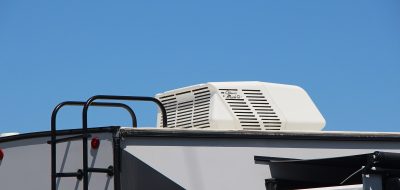Dear RV Doc,
I have a 1969 Apache pop-up that I am trying to bring back from the dead. I have a question on electrical power. I would like to keep the 12-volt DC and 120-volt AC systems separate. I am thinking that I can take a 30-amp shoreline cord to a 30-amp breaker and then run wires for the outlets from there. I would like to power a small refrigerator, heater and maybe a small home air conditioning unit, then I would use the 12-volt battery system to power the lights. Also I have the original heater that can be run off battery power, but I have heard that the old ones are not safe.
Mike Wedin, (Denver, CO)
Answer:
 Mike, when rewiring an older RV, even a pop-up, it’s vital to always keep the AC separate from the DC. The two electrical systems are not compatible for obvious reasons.
Mike, when rewiring an older RV, even a pop-up, it’s vital to always keep the AC separate from the DC. The two electrical systems are not compatible for obvious reasons.
The 30-amp shoreline cord must terminate at a “J” box or at the AC panelboard distribution panelboard (breaker box). The incoming AC power first goes through the 30-amp main breaker, but then you’ll have to have individual branch circuits, also protected by breakers. For a small RV like yours, I would recommend you have one breaker for all the 120-volt receptacles and one dedicated breaker for just the air conditioner.
Though I’ve seen small window air conditioners mounted in RVs, they look awkward and certainly are not manufactured to travel down the road. Instead I’d proffer using a small RV roof-mounted air conditioner; assuming you have sufficient roof supporting. In addition, I would recommend a separate circuit breaker for the AC to DC converter/battery charger. The converter is that electrical hub where AC meets DC in an RV. Besides powering everything 12-volt DC in the camper, (lights, fans, furnace, etc.) the converter/charger will keep the battery charged whenever you plug into shore power.
All DC circuits must also be individually protected by 12-volt fuses or breakers as well. There is a rigid code and standards that should be followed. The National Electrical Code (NEC) should be used as a reference. As far as the furnace is concerned, indeed some of those older furnaces were prone to combustion chamber failure. But if it’s been properly maintained and all things LP have been checked out (possible leaks, delivery line pressure, cleaning and servicing, correct operation, etc.), then older appliances are fine to use though parts acquisitioning may be more difficult; especially with your particular vintage. In light of the improved technology and efficiency of the units available today, I’d seriously consider upgrading to a newer, lighter furnace.
Your project is doable, but safety practices must be followed. If you don’t have specific electrical experience, you might consider having a pro RV technician give you a hand. All in all, sounds like a fun project!
(Please feel free to comment, however, please also note that due to the volume of communications I receive from multiple channels I cannot guarantee a personal response in every instance. However, questions of an overall general interest may be considered and published in an upcoming RV Doctor column.)



